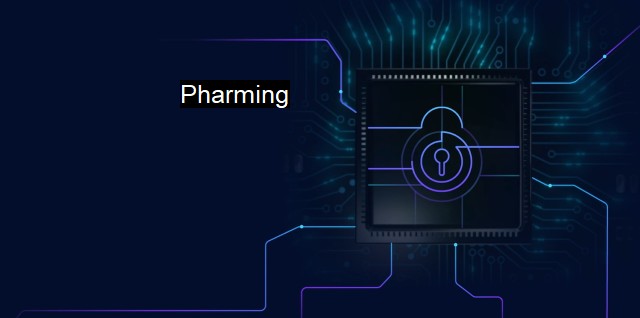What is Pharming?
The Rising Threat of Pharming: Understanding DNS Poisoning and Malware-Based Attacks in Cybersecurity Today
Pharming, in the context of cybersecurity and antivirus measures, refers to a type of cyber-attack where malicious agents arrange for the transfer of a website's traffic to a fake website. It is a scamming method designed to deceive users into revealing their personal information. While pharming may sound similar to its counterpart, phishing, a significant difference is that phishing requires the victim to click on a deceptive link voluntarily. Conversely, pharming’s activity is relatively invisible to the user and triggers automatically.The word "pharming" comes from two other words, namely "phishing" and "farming". In phishing, an attacker utilizes fake emails or websites to steal sensitive information, while farming refers to a strategy whereby a perpetrator seeks to harvest numerous pieces of critical data stored on a computer or a network system. The term is somewhat illustrative of how the scamming process works: cultivating and gathering useful data harvested via malicious means.
In practice, pharming attacks function by exploiting DNS servers, which are akin to the Internet's phone books. DNS servers typically direct internet queries to the appropriate IP address that correlates to a website's domain name. in pharming, cyber attackers manipulate the DNS server system by infecting it with corrupt data. This fraudulent activity leads to innocent users being redirected to a fake website, which is often designed to look and feel like the real thing.
In a pharming attack, if a user enters sensitive information like their username, passwords, and financial details on the fake site, the swindler steals the data. Even deft internet users who can avoid phishing scams may often find themselves a victim of pharming due to the sophisticated nature of the attack. This type of breach occurs silently and often catches the user unawares, proving a significant challenge to cybersecurity.
Pharming can wreak havoc on both the individual user and the corporations vulnerable to these attacks. For individuals, direct consequences often include identity theft or financial loss. Companies may experience significant interruptions to services, damage to reputation, financial hardships, and possible legal repercussions if they don't adhere to data protection standards.
Anti-malware and antispyware software can provide base-level protection against pharming. pharming's stealth methods require more sophisticated tactics and a more in-depth defence strategy—generating a need for antivirus software specifically programmed for this threat.
One essential measure to protect against pharming attacks is to maintain an updated browser, as newer versions often include enhanced security features. Also, use of secure website connections (HTTPS) as opposed to HTTP provides additional protection, as HTTPS is encrypted and, therefore, harder to compromise. And, of course, it's beneficial to regularly update firewall rules and apply patches to system and software flaws at personal and corporate levels.
Stringent antivirus policies such as multi-factor authentication (MFA), regular system audits, and encrypted connections can deter pharming attempts. The implementation of high-grade network and website-related security measures, such as Secure Sockets Layer (SSL) certificates, can effectively prevent DNS cache poisoning type of pharming attacks.
Also crucial are enhanced user awareness and proper education regarding cyber threats, their implications, and possible preventive strategies. Users should contemplate the inherent securities and vulnerabilities of their chosen browser or operating system, and keep up-to-date on their latest developments.
Pharming is a nefarious cyber tactic that relies on stealth and deception, challenging both individual users and corporations' cybersecurity. As technology evokes and progresses, so does the cunning of cyber attackers. Hence, educating oneself about such threats and incorporating appropriate defensive strategies becomes more critical than ever before. As responsible netizens, knowledge about pharming attacks is our first line of defence rallying against such cybersecurity threats.

Pharming FAQs
What is pharming?
Pharming is a cyber attack that redirects users’ web traffic to a fake website that mimics a legitimate one.How does pharming work?
Pharming works by exploiting vulnerabilities in the Domain Name System (DNS) of a website. Cybercriminals use several techniques, including DNS cache poisoning or malware, to modify the DNS settings and redirect users to a fake website.How can I protect myself from pharming attacks?
To protect yourself from pharming attacks, you should keep your antivirus and operating system up-to-date. Also, use a reputable DNS service provider, as it can protect against DNS cache poisoning. Finally, ensure that your browser shows a padlock icon and has an HTTPS in the URL when visiting a website, indicating a secure connection.What should I do if I suspect that my device is affected by a pharming attack?
If you suspect that your device is affected by a pharming attack, you should disconnect your device from the internet, scan your device with an updated antivirus program and contact your internet service provider. You should also change your passwords for all online accounts and monitor your financial statements for any unauthorized transactions.| | A | | | B | | | C | | | D | | | E | | | F | | | G | | | H | | | I | | | J | | | K | | | L | | | M | |
| | N | | | O | | | P | | | Q | | | R | | | S | | | T | | | U | | | V | | | W | | | X | | | Y | | | Z | |
| | 1 | | | 2 | | | 3 | | | 4 | | | 7 | | | 8 | | |||||||